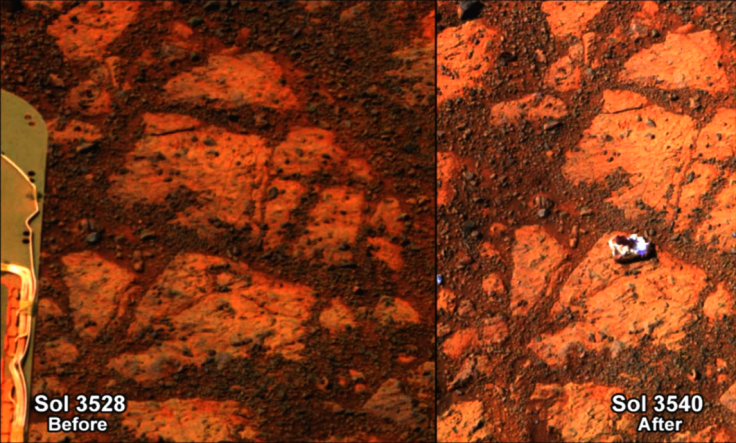Alien Life Lawsuit: Rhawn Joseph Claims NASA Is Involved In A Cover Up Over Mars ‘Jelly Doughnut’ Rock

Scientist Rhawn Joseph has filed a lawsuit over what he alleges to be a conspiracy involving NASA, Mars and a mysterious rock. Joseph claims the space agency refused to investigate what he deemed to be alien life on Mars, calling the conclusions reached by NASA as “little more than magical thinking.”
Joseph filed the lawsuit in the United States District Court, Northern District of California, reports Popular Science. Joseph, working as an astrobiologist, claims NASA has failed to investigate evidence of life on Mars. The astrobiologist discusses his working, published in the Journal of Cosmology, that concludes the “jelly doughnut” rock that suddenly appeared in front of the Opportunity rover is a “ a fully grown bowl-shaped organism resembling Apothecia.”
The abstract reads, “What appears to be spore-producing "paraphyses" can be observed on the structure, as is apparent upon magnification and which is typical of Apothecia. Apothecia are composite organisms, a mixture of fungus and cyanobacteria.” Joseph refutes NASA’s claims that the object is either a rock or piece of debris from a nearby impact.
Joseph is focusing on the “jelly doughnut” rock that was discussed during a public event for Opportunity’s 10th anniversary. The Mars rover first photographed the outcrop on Sol 3528 and again 12 days later, Sol 3540. Despite not traveling over the area, Opportunity discovered a mysterious rock, dubbed “Pinnacle Island.”
Steve Squyres, lead scientist for the NASA Mars Exploration Rover mission, said at the time, “It just plain appeared at that spot and we haven’t driven over that spot.” During their initial analysis of the rock, the “jelly” part has a high concentration of magnesium, sulfur and manganese than other Martian rocks. For now, the team has yet to reach a definitive conclusion as to how the rock got there, they believe it may have been knocked over by Opportunity’s wheel as it was making a turn, but do they determine it is a rock and not a sign of Martian life.
While life on Mars would be a significant discovery, Joseph says NASA has refused to actually investigate the rock with all photographic evidence taken by Opportunity being of “low resolution” and “slightly out of focus.” Joseph says he discovered the evidence of a Martian organism after magnifying the images.
After comparing structural examples of apothecia, or “shield lichen,” with what was found on Mars, including the “paraphyses,” the “spore producing organs, he concludes the organism grew over the twelve days that Opportunity photographed the rock outcrop. “Typically, if deprived of moisture, Apothecia will quickly dry and dehydrate and then become quite brittle--exactly as depicted in the photos of the Martian ‘mystery" structure,’” states Joseph.
Despite this evidence, NASA has yet to acknowledge the Mars mystery rock is in fact evidence of life. Joseph’s lawsuit laws out his claims as well as detailing the ways he tried to contact NASA officials to research the rock. Joseph is not seeking damages but wants NASA to “take 100 high resolution close-up in-focus photos of the specimen identified in Sol 3540, at various angles, from all sides, and from above down into the "bowl" of the specimen, and under appropriate lighting conditions which minimize glare. Take a minimum of 24 microscopic in-focus images of the exterior, lip, walls, and interior of the specimen under appropriate lighting conditions. NASA, and the rover team, must make public and supply Petitioner with all high resolution photos and images of that specimen.”
As io9 points out, Joseph does not have the best reputation within the scientific community. The Journal of Cosmology tends to have some dubious articles and would not be considered as reputable as journals such as Nature or Science. The journal previously hosted a dubious "proof of alien life" article last year and has a history of publishing research that has been deemed "Way, way, way ridiculously oh-holy-wow-how-could-anyone-publish-this wrong."
The full lawsuit, courtesy of Popular Science, can be viewed below.
© Copyright IBTimes 2024. All rights reserved.






















